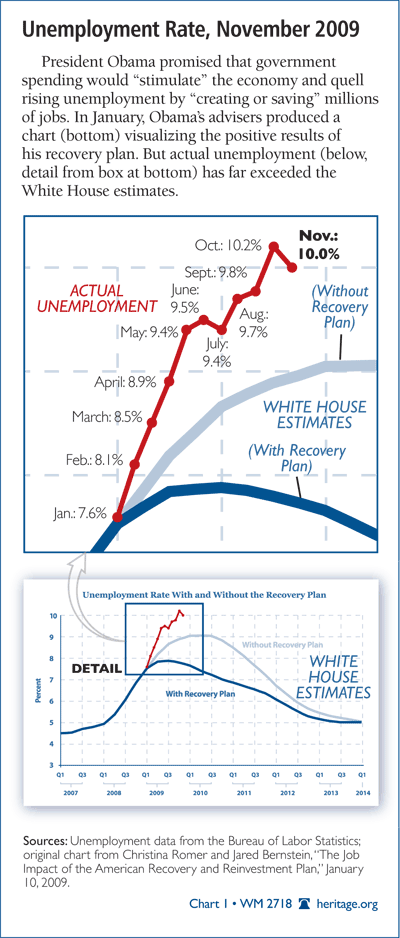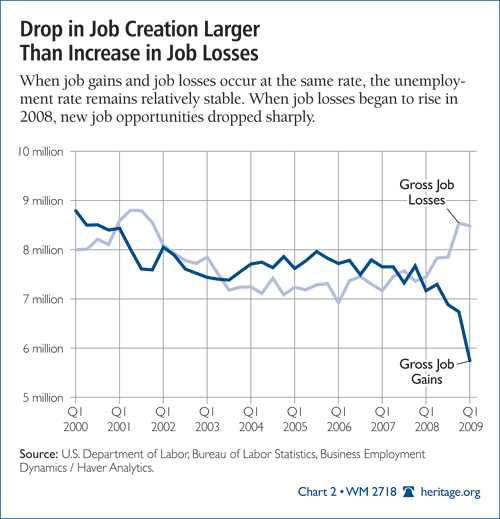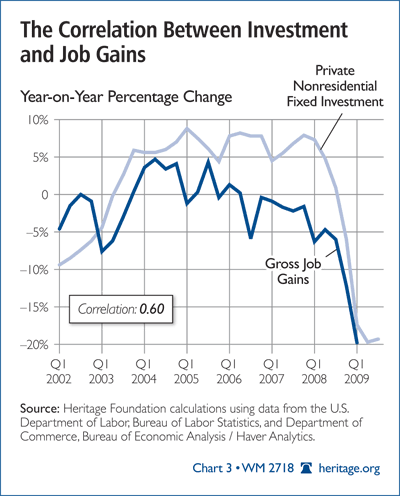Today’s jobs numbers, released the day after the White House jobs summit, show that Christmas has come early for many workers. Employers shed only 11,000 net jobs while the unemployment rate fell from 10.2 percent to 10.0 percent. While it is only a one-month snapshot, this report gives reason for optimism that a turnaround in the labor market could come sooner than expected.
However, this turnaround may proceed at a much slower pace than previous recoveries. Job losses in this downturn are the result of a sharp drop in private-sector job creation. Reduced private-sector investment—rather than an increase in layoffs—is the primary engine driving higher unemployment. Yet the Obama Administration has done little to address this problem, focusing instead on increasing government spending rather than encouraging entrepreneurial activity. In a telling example of the White House’s approach toward employment, yesterday’s job summit excluded groups that represent job creators like the Chamber of Commerce and the National Federation of Independent Businesses.
The November Jobs Report

With job losses far below expectations and a small decline in the unemployment report, the November report was a surprise for which many will be thankful. Job losses of the previous two months were substantially revised downward, indicating that the labor market is regaining its footing. It seems likely that the labor market is about to hit bottom before resuming some tepid growth.
The report is not entirely good news, however. The unemployment rate fell from 10.2 to 10 percent in part because 98,000 workers left the labor force. Most of these workers were teenagers: 62,000 teens left the labor force. About 70,000 men age 20 and over left the labor force, but 35,000 women of the same age entered the labor force. These numbers reflect the difficulty that labor force entrants have had in finding new jobs. Since teenagers are far more likely to be unemployed, this helped reduce the unemployment rate. It is likely that the unemployment rate will climb once potential workers reenter the labor force.
Another positive indication contained in the jobs report is that the hours of work increased for the week. Employers also increased overtime work, a sign that even with strong productivity growth, employers need more work hours to meet demand. The next step will be for employers to hire new workers, which will hopefully happen in the next few months.
The losers for the month were the usual suspects: construction (–27,000) and manufacturing (–41,000). The service sector had a small gain (58,000), but retail trade (–15,000) was down as retailers did not staff to usual “holiday shopping” levels.
Professional and business services (86,000) and education and health services (40,000) also increased hiring. Temporary help (52,400) hiring boomed again in November as well. Historically, a turnaround in temporary help hiring is the precursor to the entire labor market rebounding.
The sourest note in the jobs report was the 293,000 increase in the number of workers unemployed for more than six months. The average duration of unemployment also rose from 26.9 to 28.5 weeks. Unemployed workers continue to have great difficulty in finding new jobs.
Less Job Creation Behind Net Job Losses
Despite this relatively good news, the nature of job losses in this recession suggests that the labor market recovery will be slow. Media coverage of net job losses in the recession gives the impression that unemployment has risen primarily because layoffs have increased. That is partly true: Layoffs have increased over the past year and a half, and they are painful for the workers involved. But the main reason unemployment has risen is because job creation has fallen.[1] As a result, those without work stay unemployed longer, thereby driving up the unemployment rate.
The Bureau of Labor Statistics uses unemployment insurance records to measure the total increase and the total decrease in jobs across individual companies over time.[2] The most recent figures available are through the first quarter of 2009 and are shown in chart 2.

Since the recession started, quarterly job losses have increased by 15 percent (1.1 million jobs) while job creation has fallen by 25 percent (1.9 million jobs). The number of workers laid off at companies going out of business rose by 7 percent (91,000 jobs) and the number of workers hired at newly formed businesses fell by 22 percent (313,000 jobs). Like the proverbial “dog that did not bark,” unemployment has risen primarily because of the private-sector jobs that are not being created. Research into past economic downturns suggests that lower job creation will continue to account for most of the net job losses throughout this recession.[3]
Why has private-sector job creation fallen so sharply? Businesses are retrenching wherever they can, taking measures to survive the immediate downturn such as laying off workers and conserving cash. The policy agenda in Washington—the health care legislation, cap-and-trade legislation, higher taxes to pay for more spending—has also contributed to businesses’ unease about the future. Entrepreneurs are reluctant to invest when they fear that federal legislation could make their business projects unviable.
Less Investment Means Fewer Jobs
Annual private investment has fallen by $316 billion since the recession started—a 20 percent drop.[4] This fall continued even after the stimulus became law, providing a clear indication that less private investment means less job creation. As long as business investment remains low and entrepreneurs refrain from starting new enterprises, job creation will remain low and unemployment will stay high.

The data show this clearly. Chart 3 shows the percent year-on-year change in job gains and business investment. They are strongly correlated: Job creation has fallen as investment has slowed.
Entrepreneurship: The Ignored Answer
Obama’s signature jobs initiative was the stimulus package, but the bill did little to promote private-sector investment or job creation. The new government spending in the stimulus does not encourage entrepreneurs to start or expand a business enterprise unless they received a stimulus contract. Consequently, the stimulus ignores the main factor increasing unemployment: lack of private investment. Instead of encouraging private-sector job creation, the stimulus bill increased government spending on longstanding liberal priorities.
The Obama Administration’s approach to yesterday’s “jobs summit”—excluding the Chamber of Commerce and the National Federation of Independent Businesses, the principle federations that represent private-sector job creators—further illustrates this shortsightedness.
As long as entrepreneurs remain reluctant to invest, job creation will lag and the recovery will be slow. Even if the labor market is close to bottoming out, Americans could be headed for a prolonged, jobless recovery. Given that employers must create a net 125,000 jobs a month to keep up with the growth of the labor force and prevent unemployment from rising, unemployment will probably remain unacceptably high for quite some time.
Job Creation 101
What creates jobs? Entrepreneurs with ideas for new or better ways of doing things who successfully put their business plans into action. As long as entrepreneurial activity remains low, unemployment will remain high. However, the policy solutions advanced by the Obama Administration largely ignore this fact. The federal spending in the stimulus bill did little to encourage entrepreneurs to start or expand businesses.
Today’s jobs report gives hope that the labor market may soon bottom out, but unemployment remains unacceptably high, and jobs are still difficult for unemployed workers to find. Any recovery will be weak and jobless as long as entrepreneurs remain on the sidelines.
James Sherk is Bradley Fellow in Labor Policy in, and Rea S. Hederman, Jr., is Assistant Director of, the Center for Data Analysis at The Heritage Foundation.


